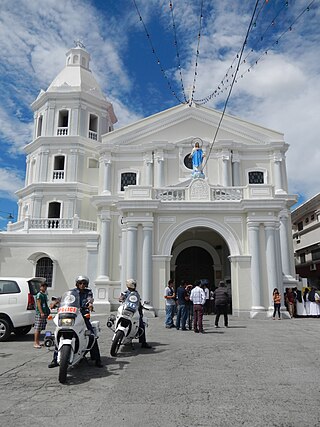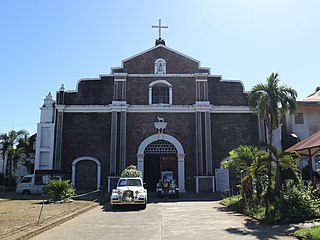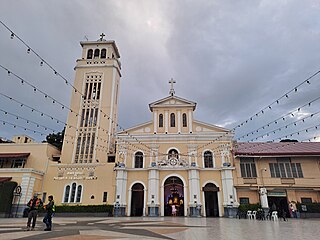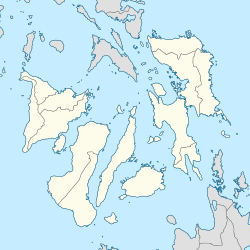
Hilongos, officially the Municipality of Hilongos, is a 2nd class municipality in the province of Leyte, Philippines. According to the 2020 census, it has a population of 64,514 people.

Pedro Calungsod, also known as Peter Calungsod and Pedro Calonsor, was a Catholic Filipino-Visayan migrant, sacristan and missionary catechist who, along with the Spanish Jesuit missionary Diego Luis de San Vitores, suffered religious persecution and martyrdom in Guam for their missionary work in 1672.

The Augustinian Province of Sto. Niño de Cebu, based in the city of Cebu in the Philippines, is a geographical and administrative subdivision of the religious Order of St. Augustine. The Province is actively involved in education, parish administration, mission work and formation of candidates for religious life. It has worked on joint missions with other Augustinian provinces, namely, the Australian Province in South Korea, the Dutch Province in Indonesia, and the Provinces of Villanova, Ireland and England-Scotland in South Africa. In keeping with its goal to become a missionary Province, it has begun sending friars overseas to help in apostolic and pastoral ministries.

The Minor Basilica and National Shrine of Jesus Nazareno (Black Nazarene), popularly known as Quiapo Church and canonically as the Saint John the Baptist Parish, is a prominent basilica in the district of Quiapo in the city of Manila, Philippines. It is the home of the Black Nazarene, a dark statue of Jesus Christ said to be miraculous. The basilica is under the jurisdiction of the Archdiocese of Manila under the Vicariate of José de Trozo and its current rector is Rev. Fr. Rufino C. Sescon, Jr.

The Archdiocese of San Fernando is the archdiocese of the Latin Church of the Catholic Church in Pampanga, Philippines which has territorial jurisdiction over the whole province of Pampanga and Angeles City. The archdiocese is also the metropolitan see of the ecclesiastical province of the same name, which also include three dioceses of its surrounding provinces of Bataan, Zambales, and Tarlac. The cathedral church and seat of the archdiocese is the Metropolitan Cathedral of San Fernando (Pampanga). The Virgin Mary, under the title Virgen de los Remedios, is the principal patroness.

The National Shrine of Our Lady of the Candles, also known as the Metropolitan Cathedral of Saint Elizabeth of Hungary and colloquially as Jaro Cathedral, is a cathedral located in the district of Jaro in Iloilo City, on the island of Panay in the Philippines. The seat of the Roman Catholic Archdiocese of Jaro, it was placed under the patronage of Saint Elizabeth of Hungary. It was established in 1575 as a visita (chapel-of-ease) of Oton by the Augustinians and as a separate parish in 1587. The present-day structure of Jaro Cathedral was built in 1874.

The Augustinian Recollect Province of Saint Ezequiél Moreno is a division of the Order of Augustinian Recollects that has jurisdiction over the Philippines, Taiwan and Sierra Leone. It officially separated from the Province of Saint Nicholas de Tolentine on 28 November 1998. Today, the Provincialate House is located at the San Nicolas De Tolentino Parish Church on Neptune Street, Congressional Subdivision, Project 6, Quezon City.
San Agustin Center of Studies is a seminary located in Diliman, Quezon City, Philippines. It was founded in 1984.

The Our Lady of the Pillar Parish Church, commonly known as the Santa Cruz Parish Church and also designated as the Archdiocesan Shrine of the Blessed Sacrament, is a Mission Revival Roman Catholic parish church in the district of Santa Cruz, Manila, Philippines. It was built when the arrabal (suburb) of Santa Cruz was established by the Jesuits in the early 17th century. The church had undergone many repairs and reconstruction, with the last reconstruction done in the 1950s.

The Saint Anne Parish Church, also known as Santa Ana Church or also known in its formal name as the Minor Basilica and Archdiocesan Shrine of St. Anne, is a Roman Catholic church and minor basilica located in Barangay Santa Ana, Taguig, Philippines. It is situated next to the Taguig River and across Plaza Quezon, where the statue of Manuel L. Quezon was erected when he was still serving as President of the Philippines. Saint Anne is the patroness of the church.

The Church of Pila,also known as the San Antonio de Padua Parish Church, is a Roman Catholic church dedicated to Saint Anthony of Padua in the Philippines in 1578 and the first Antonine parish church in the Philippines in 1581 and probably in Asia. It is also designated as the National Shrine of San Antonio de Padua of the Catholic Bishops' Conference of the Philippines on April 23, 2019. In 1606 the Franciscans set up the second printing press of the Philippines under the supervision of Tomás Pinpín and Domingo Loag. Its titular is Anthony of Padua, whose feast is celebrated every June 13.

St. Andrew the Apostle Parish, commonly known as Bacarra Church is a Roman Catholic church located in the municipality of Bacarra, Ilocos Norte, Philippines under the jurisdiction of the Roman Catholic Diocese of Laoag.

The San Pedro Apostol Parish Church, commonly known as Loboc Church and alternatively as the Diocesan Shrine of Our Lady of Guadalupe in Extremadura, is a Roman Catholic church in the municipality of Loboc, Bohol, Philippines, within the jurisdiction of the Roman Catholic Diocese of Tagbilaran.

The Diocesan Shrine and Parish of San Miguel Arcangel, is a 19th-century, Baroque Roman Catholic church located along De Leon St., Brgy. Poblacion, San Miguel, Bulacan, Philippines. The parish church, with Saint Michael, the Archangel as patron saint, is under the jurisdiction of the Roman Catholic Diocese of Malolos.

The National Shrine and Parish of Saint Anne, commonly known as the Santa Ana Shrine or Hagonoy Church, is an 18th-century, Baroque Roman Catholic church located at Brgy. Santo Niño, Hagonoy, Bulacan, Philippines. The parish church, under the aegis of Saint Anne, is under the jurisdiction of the Roman Catholic Diocese of Malolos. It was declared a National Shrine in 1991. In 1981, a marker bearing a brief history of the church was installed on the church by the National Historical Institute, precursor of the National Historical Commission of the Philippines.

The Archdiocesan Shrine of Patrocinio de Maria Santisima, commonly known as Boljoon Church, is a Roman Catholic church dedicated to the Our Lady of the Patronage in the municipality of Boljoon, Cebu, Philippines, under the Roman Catholic Archdiocese of Cebu.

The Minor Basilica of Our Lady of the Rosary of Manaoag, commonly known as Manaoag Church, is a Roman Catholic minor basilica located in Manaoag, Pangasinan in the Philippines.

The National Shrine of Saint Joseph, commonly known as Mandaue Church, is a Roman Catholic parish church located at the center of Mandaue City, Philippines. The parish jurisdiction covers the civil barangays of Guizo, Centro, Looc, and Mantuyong.

The Diocesan Shrine and Parish of Our Lady of Mercy is a Roman Catholic church under the Diocese of Novaliches in the Philippines. It is the oldest parish in the diocese, established in 1856 by the Augustinian missionaries from Spain.
Vicente Hermosa Garces, also known as Vicente Garces and Nyor Inting, was a Filipino Visayan politician, writer, and poet. His famous written works in Cebuano were published in Visayan newspaper, Bag-ong Kusog. He also served as mayor in the then municipality of Talisay, Cebu, Philippines from 1925 to 1937.























